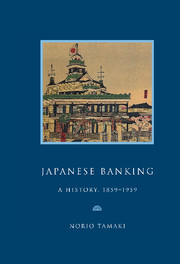Book contents
- Frontmatter
- Contents
- Preface
- Genealogy of leading Japanese banks, 1859–1959
- List of abbreviations
- Map
- Part I A bankrupt Shogunate, 1859–1868
- Part II The Meiji Restoration: monetary confusion and banking experiments, 1868–1881
- Historical background
- 5 The first banking experiment, 1868–1872
- 6 The national bank system: the American influence, 1870–1881
- 7 The origins of ordinary banking: another bank mania, 1875–1881
- 8 The search for stability: the last bank controversy, 1879–1881
- Part III Matsukata, the wizard of Japanese banking, 1881–1897; the Yokohama Specie Bank (1880) and the Bank of Japan (1882)
- Part IV The Japanese on the London money market, 1897–1911
- Part V War, the Japanese boom years, 1911–1919
- Part VI Crisis and the road to war, 1919–1937
- Part VII Complete commitment, struggle and defeat, 1937–1945
- Part VIII American ‘democratisation’ and the search for growth, 1945–1959
- An extraordinary century, 1859–1959
- Appendices
- Notes
- Bibliography
- Index
6 - The national bank system: the American influence, 1870–1881
Published online by Cambridge University Press: 03 February 2010
- Frontmatter
- Contents
- Preface
- Genealogy of leading Japanese banks, 1859–1959
- List of abbreviations
- Map
- Part I A bankrupt Shogunate, 1859–1868
- Part II The Meiji Restoration: monetary confusion and banking experiments, 1868–1881
- Historical background
- 5 The first banking experiment, 1868–1872
- 6 The national bank system: the American influence, 1870–1881
- 7 The origins of ordinary banking: another bank mania, 1875–1881
- 8 The search for stability: the last bank controversy, 1879–1881
- Part III Matsukata, the wizard of Japanese banking, 1881–1897; the Yokohama Specie Bank (1880) and the Bank of Japan (1882)
- Part IV The Japanese on the London money market, 1897–1911
- Part V War, the Japanese boom years, 1911–1919
- Part VI Crisis and the road to war, 1919–1937
- Part VII Complete commitment, struggle and defeat, 1937–1945
- Part VIII American ‘democratisation’ and the search for growth, 1945–1959
- An extraordinary century, 1859–1959
- Appendices
- Notes
- Bibliography
- Index
Summary
Banking controversy, 1870–1872
Although the prestigious ryogae financial houses resisted the government scheme of organising them into joint-stock companies, they did not object in principle to the idea of transforming themselves into modern banking houses. Witnessing the collapse of the ill-fated exchange companies, enterprising ex-ryogae merchants thought that the opportunity had arrived for them to set up their own bank institutions. The movement became quite fashionable from the summer of 1871 when Mitsui took the initiative. In the prospectus submitted to the Finance Ministry, Mitsui designated themselves as ‘Mitsui Gumi Bank’. They proposed to issue their own gold-convertible banknotes which they would support by 75 per cent gold reserves. These notes would circulate alongside the government notes. They also claimed that their ‘bank’ would follow the principles of note-issuing pursued by the Bank of England.
There followed a series of bank prospectuses. In January 1872, enterprising merchants in Tokyo, supported by the new city corporation, submitted a prospectus of a ‘Bank of Tokyo’, which was to be engaged in supplying funds for developing the new capital city. In February, the house of Ono, another great ryogae house, ranking with Mitsui among the Edo ryogae community, proposed to establish themselves rivalling Mitsui as ‘Ono Gumi Bank’. Then in April, the proprietors in Otsu Exchange Company decided to set up their own bank to be designated as ‘Goshu Bank’ in order to supply monetary resources to the locality of Lake Biwa north of Kyoto, where there were several commercial centres in the Edo era.
- Type
- Chapter
- Information
- Japanese BankingA History, 1859–1959, pp. 28 - 39Publisher: Cambridge University PressPrint publication year: 1995
- 1
- Cited by



